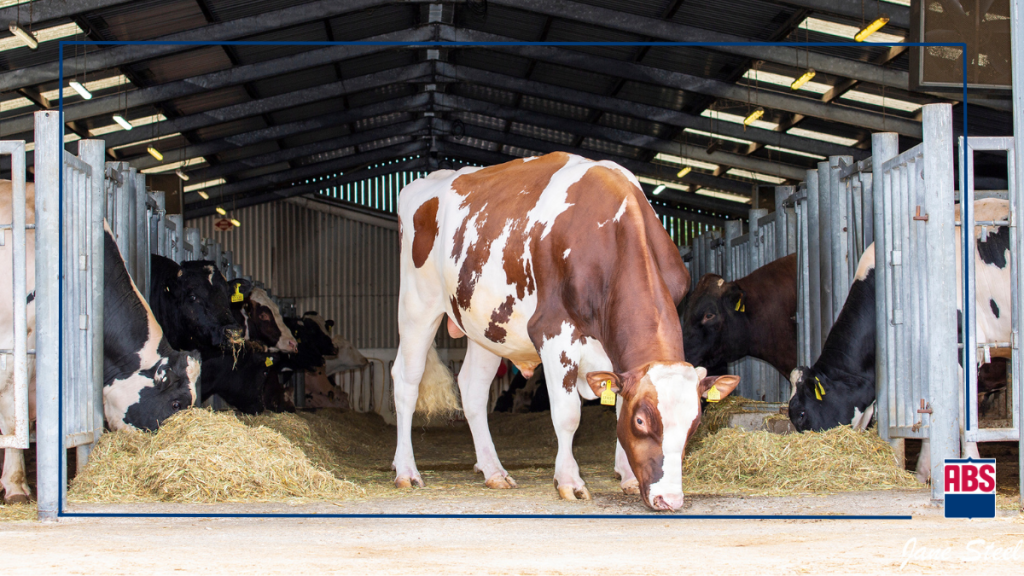Use dairy crossbreeding as a solution that gives you more, faster. Focus on creating a dairy crossbreeding program tailor-made for your unique herd situation.
With the wide variety of herd environments, nutrition, milk buyers, and management, there is no “one-size-fits-all” breeding program. So, ABS will help you develop a customized dairy crossbreeding program to fit your herd.
More than that, we have the people, experience, and support to help you and your team manage your crossbreeding program and foster the best possible results. As a full-service provider, we have the products and services to ensure your reproductive program delivers maximum efficiency and profitability. We have compiled our most frequently asked questions for you to learn more about crossbreeding.
Advantages of Dairy Crossbreeding
Use dairy crossbreeding to create the problem-free herd you want. With help from ABS, you can build a solution that fits your system perfectly and delivers excellent production, superb health, and unrivaled fertility. You can expect reduced workload and increased profits, time after time.
- Take advantage of the superior traits of various breeds
For example, Jerseys excel in solids production and Norwegian Reds have exceptional fertility and health. Using these breed advantages makes substantial, sustainable improvements in your herd. This is called “complementarity” or using breeds that will best deliver the herd you need.
- Gain heterosis or hybrid vigor which is the “free benefit” of crossbreeding that enhances performance
Improved fertility, health, and longevity contribute to increased profitability by reducing involuntary culling and creating an easier-to-manage herd.
- Change your herd faster
Taking advantage of the significant differences between breeds gives you the power to improve your herd more quickly. For example, using Jersey on Holstein can dramatically drop weight and stature in just one generation, creating a more efficient herd of cows.
If you want a cow that not only eats less but is smaller, lasts longer, breeds better, has less days to first service, less calving difficulty, less stillbirths, and better overall general health (less vet bills), then crossbreeding may be a deal for your dairy herd.
Larry F. Tranel of Iowa State University Extension and Outreach Dairy Team
Our team can help you achieve your herd goals faster by planning and creating a customized dairy crossbreeding program for your herd.
The Pros and Cons of the Breeds Commonly Used in Crossbreeding
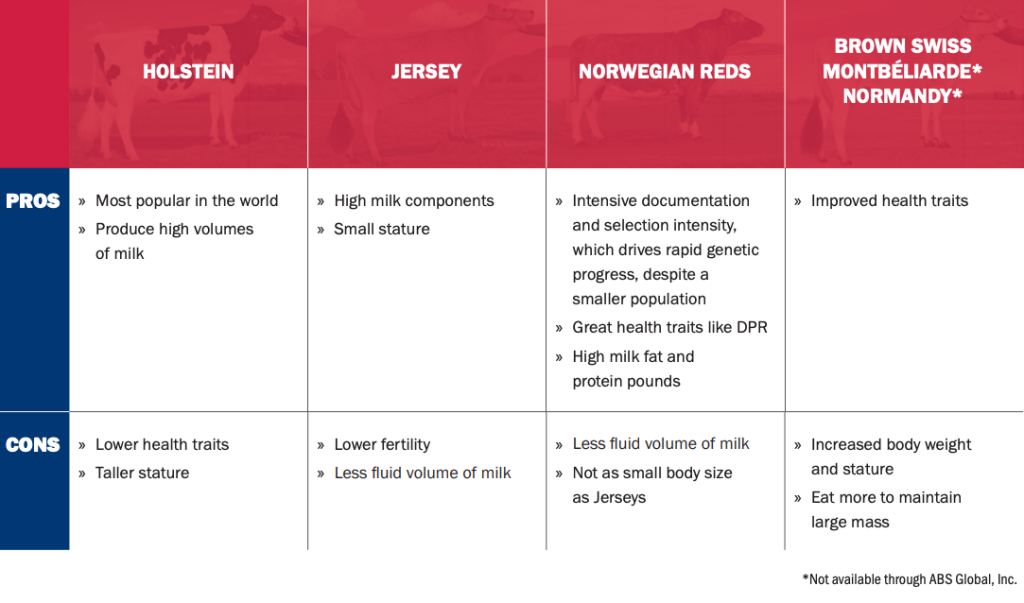
Recommended Crossbreeding Programs
At ABS, we work with our genetic partners to use crossbreeding as a tool to create cows customized for your system. Although there are many ways to customize a crossbreeding program for a herd, here are three major crossbreeding programs to consider.
Two-Way Crossing
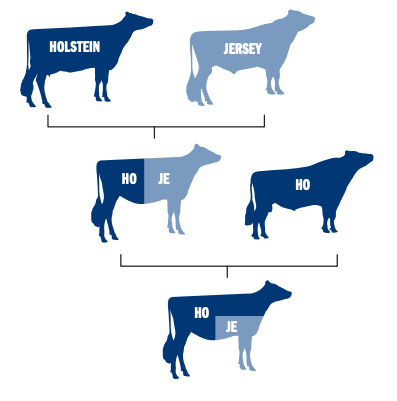
WHAT IS IT? Two-way crossing is the practice of rotating between two breeds to create a pedigree.
EXAMPLE: Breeding a Holstein dam to a Jersey sire to create an F1 crossbred calf. Next, breed the F1 calf to a Holstein sire, which would result in an F2 crossbred calf that is one-quarter Jersey and three-quarters Holstein.
WHY USE IT? This is the simplest program for crossbreeding. It is easy for the producer to quickly and correctly select the breed of sire to breed to a dam. Two-way crossing results in a sustained heterosis rate of about 66 percent.
Three-Way Crossing
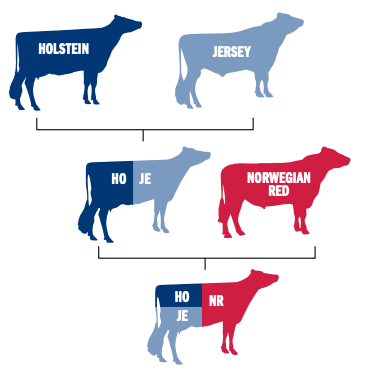
WHAT IS IT? Three-way crossing is the practice of using three breeds in a rotation to create a pedigree.
EXAMPLE: Breeding a Holstein dam to a Jersey sire to create an F1 crossbred calf. Next, the F1 calf would be bred to a third breed, such as Norwegian Red. The resulting F2 crossbred calf would be one-fourth Holstein, one-fourth Jersey, and one-half Norwegian Red.
WHY USE IT? Utilizing three-way crossing allows for about 85 percent sustained heterosis. However, it can be harder to execute correctly since there is more opportunity for error. Herds using this program must be diligent to correctly identify the sire of a calf from conception until breeding date.
F1 Sires
There has been a lot of discussion over the use of F1 sires in dairy crossbreeding programs. To make breeding decisions simpler, some are advocating to breed crossbred F1 sires to crossbred dams. This kind of breeding mentality, in our opinion, may do more harm than good to your herd. We believe there are three reasons not to use dairy F1 sires on F1 dams: phenotypic variation for resulting progeny, lack of selection intensity, and unreliability of crossbred genetics. Keep reading to learn more about the crossbreeding system we suggest for your F1 females.
Terminal F1 Crossing
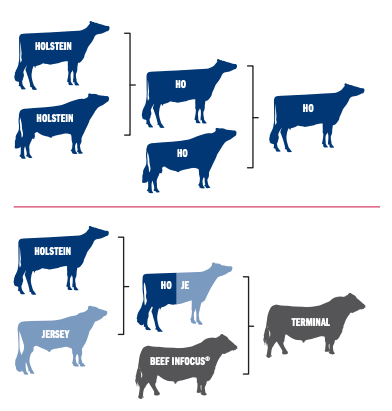
WHAT IS IT? Terminal F1 crossing uses a population of a herd that remains a purebred nucleus herd. From this “nucleus herd,” producers create both replacement purebreds and F1 crosses. The F1 crosses are bred to Beef InFocus® to create a superior beef cross calf. This method results in a herd that is about partially purebred and partially F1 crossbreds. Alternatively, F1 embryos are available through ABS.
EXAMPLE: A herd that is partially F1 and partially pure Holstein uses sexed semen and embryo technology to maintain a population of pure Holsteins and a population of F1 Holstein x Jersey crosses. These F1s are then bred to Beef InFocus®.
WHY USE IT? This program offers the ability to shift genetics more quickly to respond to market demands, maximize heterosis in the F1 herd, and use tools that are not available to fully crossbred herds, such as genomics. However, there is an increase in management complexity, and the purebred half of the herd will lack heterosis.
Design Your Dairy Crossbreeding Program
- Create a priority list of what you want to achieve from your crossbreed herd
- Identify the breeds that are most relevant or complementary to your herd
- Choose your crossbreeding system
- Two-way cross
- Three-way cross
- Terminal F1 cross
- Design a long-term plan for creating your custom herd of crossbreds
- Select the sires that match your herd’s priorities
Crossbreeding is a solution that gives you more, faster. Time after time, you can expect a reduced workload and increased profits from crossbred cows by delivering excellent production, superb health, and unrivaled fertility. With the help of ABS, you can tailor make your crossbreeding program for your unique herd, system, and environment.
Explore the possibilities for faster herd improvement with dairy crossbreeding by contacting your ABS Representative or completing the form below.



